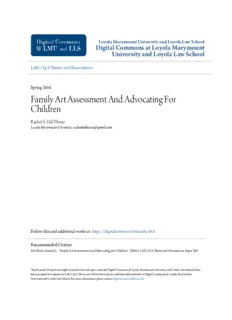
Family Art Assessment And Advocating For Children PDF
Preview Family Art Assessment And Advocating For Children
LMU/LLS Theses and Dissertations Spring April 2016 FFaammiillyy AArrtt AAsssseessssmmeenntt AAnndd AAddvvooccaattiinngg FFoorr CChhiillddrreenn Rachel L. Del Dosso Loyola Marymount University, [email protected] Follow this and additional works at: https://digitalcommons.lmu.edu/etd Part of the Art Therapy Commons, and the Marriage and Family Therapy and Counseling Commons RReeccoommmmeennddeedd CCiittaattiioonn Del Dosso, Rachel L., "Family Art Assessment And Advocating For Children" (2016). LMU/LLS Theses and Dissertations. 290. https://digitalcommons.lmu.edu/etd/290 This Research Projects is brought to you for free and open access by Digital Commons @ Loyola Marymount University and Loyola Law School. It has been accepted for inclusion in LMU/LLS Theses and Dissertations by an authorized administrator of Digital Commons@Loyola Marymount University and Loyola Law School. For more information, please contact [email protected]. FAMILY ART ASSESSMENT AND ADVOCATING FOR CHILDREN by Rachel Del Dosso A research paper presented to the FACULTY OF THE DEPARTMENT OF MARITAL AND FAMILY THERAPY In partial fulfillment of the requirements for the degree MASTER OF ARTS May, 2016 FAMILY ART ASSESSMENT AND ADVOCATING FOR CHILDREN 2 ABSTRACT This study explores how Landgarten’s Family Art Assessment can provide clinicians with valuable information about families that can be used to advocate for the needs of the children in the family. A comprehensive literature review covers family assessments using art developed by Psychologists, family art assessments created by art therapists, and the benefits of using them in clinical treatment. The researcher utilized a qualitative research approach. The data gathering took the form of surveys and semi-structured interviews with clinicians at a community mental health agency following their participation/observation in a Family Art Assessment administered to a family on their caseload by a board certified art therapist. The researcher used textual analysis of the interview transcription to identify emergent themes. The emergent themes included: the impact of domestic violence, power dynamic, disconnection, and the therapist’s efforts to increase connection and communication in the family. Study findings indicate that Family Art Assessments, when used as a consultation service administered by an experienced art therapist, can serve as an invaluable tool to provide clinicians with a more complete understanding of the families they are treating quicker than verbal therapy assessment methods alone. The findings also indicate that the Family Art Assessment helped clinicians conceptualize their cases from a more systemic perspective that considers the children’s environment and relational patterns within the family as contributing to their problem behaviors and symptoms, and allowed clinicians to envision a path in treatment that included advocating for the children’s needs. iii FAMILY ART ASSESSMENT AND ADVOCATING FOR CHILDREN 4 DISCLAIMER The names and identifying information of study participants have been omitted to protect their confidentiality. All of the participants who took part in the surveys and interviews were competent clinicians who gave written consent for their responses to be used in this paper and subsequent research publications. The families also gave written consent for their artwork to be used in this paper and subsequent research publications. DEDICATION This research is dedicated to my husband, Jared, who encouraged me to follow my dream of becoming an art therapist and has never wavered in providing me with the support and companionship I needed during the long and challenging journey of graduate school, practicum, and the research process. v ACKNOWLEGEMENTS I would like to extend my deepest gratitude to my fantastic research mentor, Dr. Paige Asawa, who initially sparked my interest in the Family Art Assessment as a research topic through her sharing about her passion for her own research relating to it and offered her continuous uplifting presence and reassurance throughout the research process, and guided me through this project from start to finish with tenderness, kindness, and generosity. Special thanks to my friends and family for their support and encouragement during this long process, and to the amazing faculty in the department of Marital and Family Therapy and Clinical Art Therapy at Loyola Marymount University who all shared their wisdom and contributed to my development as an art therapist through challenging me to develop nuanced understandings of what it means to do this work with integrity, passion, creativity, and careful consideration of cultural and ethical issues, and to the clinicians at Barbara Sinatra Children’s Center who willingly gave their time to participate in the study. Thank you for making this research possible. vi FAMILY ART ASSESSMENT AND ADVOCATING FOR CHILDREN 1 TABLE OF CONTENTS Abstract………………………………………………………………………………………...…iii Disclaimer………………………………………………………………………………………...iv Dedication…………………………………………………………………………………………v Acknowledgements……………………………………………………………………………….vi Table of Contents……………………………………………………………………………….…2 List of Figures……………………………………………………………………………………..3 I. Introduction…………………………………………………………………………...………...4 The Study Topic…………………………………………………………………………..4 Significance of the Study Topic…………………………………………………………..4 II. Background of the Study Topic…………………………………………………….………….6 III. Literature Review………………………………………………………………………….….7 Family Assessments Using Art Developed by Psychologists…………………………….7 Kinetic Family Drawing (KFD)…………………………………………..7 Family Centered Circle Drawing (FCCD)………………………………...8 Family Map………………………………………………………...…….10 Family Art Assessments Developed By Art Therapists……………………………...….11 Kwiatkowska’s Family Art Evaluation (FAE)………………………..…11 Landgarten’s Family Art Assessment……………………………………13 Benefits of Using Family Art Assessments in Clinical Treatment………………………15 Decreased Defenses……………………...………………………………15 Makes family dynamics visible………………………………………….16 Guides treatment planning………………………………………………18 FAMILY ART ASSESSMENT AND ADVOCATING FOR CHILDREN 2 Facilitates visualization of child’s perspective…………………………..18 IV. Research Approach……………………………………………………………...…………...21 V. Methods…………………………………………………….…………………………………22 Definition of Terms………………………………………………………………………22 Design of Study…………………………………………………………………………..22 Sampling…………………………………………………………………22 Gathering of Data…………………..……………………………………22 Analysis of Data…………………………………………………………23 VI. Results……………………………………………………………………………………….25 Presentation of Survey Data…………………………………….……………………….25 Presentation of Interview Data…………………………………………………………..29 Analysis of Interview Data………………………………………………………………34 Emergent Themes………………………………………………………………………..35 Responses to Study Questions…………………………………………………………...39 Findings………………………………………………………………………………….44 VII. Conclusion………………………………………………………………………………….47 VIII. References…………………………………………………………………………………48 IX. Appendices………………………………….……………………………………………….51 FAMILY ART ASSESSMENT AND ADVOCATING FOR CHILDREN 3 LIST OF FIGURES Figure 1…………………………………………………………………………………………..37 Figure 2…………………………………………………………………………………………..37 Figure 3…………………………………………………………………………………………..38 Figure 4…………………………………………………………………………………………..38 Figure 5…………………………………………………………………………………………..39
Description: